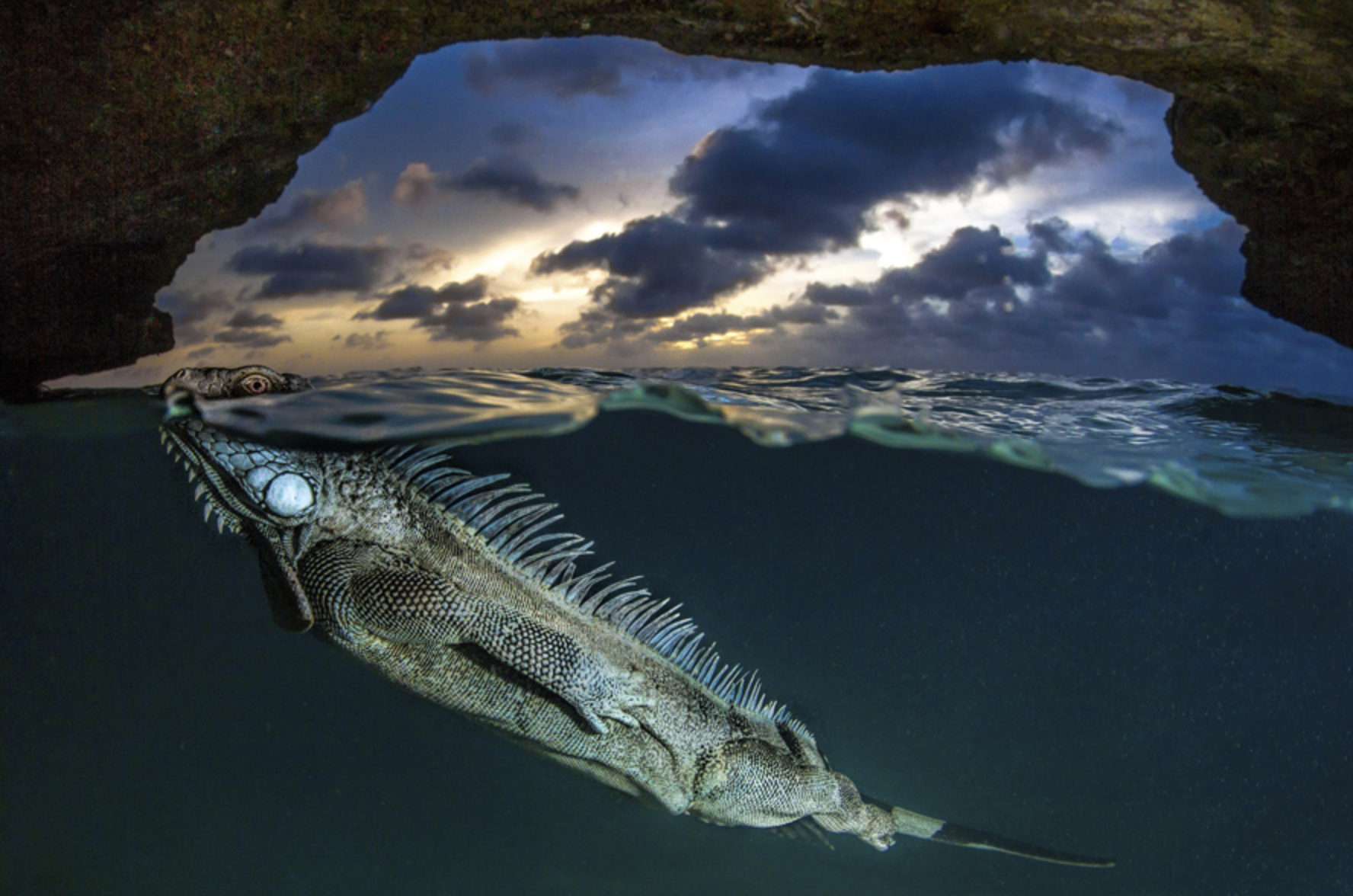Fabulous, isn’t it? As if from a fable, perhaps: “Once every 1000 years the Magical Iguana King would surface to inhale a silver bubble of air. And if at that moment he saw a sea eagle, he would become Lord of the Sea and the Sky. But if the bird was not in sight, then he would return to his sunken lair for another 1000 years.”
This iguana might be magical–after all, he is digital–and he already is a mediator between sea and sky. The photograph provides a stunning tableau of how separate worlds meet at the surface of things: three worlds, actually, as we also see the rocks of a sea cave framing the heavenly vista that extends far above and along the water. The iguana represents a fourth world, that of organic life, but it also seems to incorporate the first three in its rock-like skin, streamlined posture, and eye that can see along the rays of light permeating the air.
So it is that the photo captures a profound sense of liminality: the border between things. We see water and earth and sky and animal, but each of these separate entities is also part of the borders between them, which are something else as well. The slightly turbulent, partially illuminated surface of the water and the outline of the sky made by the rock create a sense of bounded yet dynamic space, which contrasts with the vast darkness below and the endlessness above. That border is neither one side nor the other, but both, just as the animal is neither above nor below the water, but both.
Although the act of breaking the surface will have lasted only a moment, the photograph has a sense of timelessness. The iguana looks like a prehistoric creature, the dark sea and distant sun have been there for billions of years, and there is no sign of anything having changed since then. Some say that photography shouldn’t aspire to the timelessness of art, but that’s the wrong standard anyway (and not only for photography). The beauty of this photograph has done something important, which is to show how the enormous scale of nature’s time and space also includes the magic of surfaces–of those places, often very small places, where forces meet and mingle.
And not just once.
This is another example of what I have in mind. You are looking at a wave that looks like a rock. The incredible motility of the water has acquired the solidity of rock, which we can see because of the contrast with the sky. The illusion (if you want to call it that) also is caused by the light flowing through the water, but that proves the point: what we think of as one thing is two or more; a wave is both air and sky, not to mention the motion of earth and moon. This wave is a border between sea and sky, and one might well wonder what great leviathan could be rising to break the surface.
This photo, like the one above, also seems to depict nature’s timelessness in a liminal moment. And why not? Not only are the techniques the same, but the subject is the same. That wave lasted only a few seconds, but the water and wind shaping it have been there for billions of years and will be there long after we are gone. We can sense the abstract forces coursing through the wave, and we can see texture of its surface, which is at once sea and sky. Together they communicate nature’s glory.
The wave, like view from the sea cave above, also is the product of digital processing. I wouldn’t worry about that. Like the effect of the light through the water in each scene, the tonalities of the image are neither fixed nor misleading. It is only by seeing these scenes somewhat imaginatively that one can begin to appreciate how the world is made, and that is true whether you see it through the lens of art or science. To the extent the processing helped bring out the richness of the world, so be it.
These photographs are not only an education in natural beauty; they also exemplify how photography itself is a liminal art. The photograph is a thin surface between two worlds: neither here nor there, and neither past nor present, but both. Every photograph puts us into a liminal space–a space where perhaps we can breathe a silver bubble of air and see anew.
Photographs by Lorenzo Mittig and Ray Collins at Smithsonian.com. The first was the winner and the second a finalist in the Natural World category at the Smithsonian Magazine 2014 photo contest.


Discussion